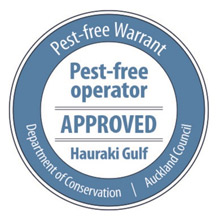Protect our wildlife
- Check – your gear for pests such as rodents and insects
- Clean – footwear and gear, removing soil and seeds
- Close – ensure your gear is zipped up (no open bags)
When you arrive on a pest-free island, you may be met by rangers to recheck your gear.
No pets on island reserves
Dogs, cats and other pets are not allowed on island reserves in the Bay of Islands, Hauraki Gulf, and Marlborough Sounds islands. Check specific rules for a place before you visit.
How to check, clean, and close
All visitors should complete the biosecurity checklist.
Matiu/Somes, Tiritiri Matangi, Motuora, Rangitoto – Motutapu and Motuihe overnight visitors: You must bring this completed biosecurity checklist and hand it to the ranger on arrival.
Fiordland islands: If you are taking your own boat you will also need to hold a 'Fiordland Clean Vessel Pass', and adhere to the Fiordland Marine Regional Pathway Management Plan.
How to pack
- Pack food in sealed containers to keep pests out.
- No open bags or supermarket bags.
Check your gear for pests
Before you leave the mainland, check and clean your gear.
- Check that your gear is free of rats, mice, ants and skinks – especially camping gear which has ideal places for them to hide when stored.
- Take extra care to clean gear if you have Argentine ants or plague skinks where you live.
- Clean clothing, footwear and camping gear, removing soil and seeds before and after each trip. Dirty gear may carry kauri dieback disease or harbour weed seeds and pests.
- Look out for cleaning stations at the pier, and scrub your shoes before boarding.
- Do not bring your pets.
If you are visiting a Hauraki Gulf island, it’s an offence to move any of the Auckland pest species.
Check your vessel for pests
If you're taking your own boat or kayak you need to:
- Check your vessel for rats, mice, ants and skinks before departing.
- Look for signs of rodents such as droppings and gnawing.
- Keep fresh bait and/or set traps on your vessel and in the area it is stored.
- Land people and supplies during the day.
- Anchor your boat offshore at night.
- Put rat guards on mooring ropes and anchor chains, and never attach mooring lines directly to land.
Travelling on commercial vessels

If you're travelling on a commercial vessel, eg a public ferry or chartered boat, make sure it is Pest Free Warranted – look for the Pest Free Warrant logo.
List of Pest Free Warrant holders.
If you find a pest
- On the mainland: Get rid of the pest and clean your gear again.
- On a commercial boat: Tell the crew what you have found and where it is.
- On your own boat or kayak: Destroy any rats, mice, ants or skinks. Don't throw rats or mice overboard alive as they can swim up to 1 km.
- On the island: Report sightings to the DOC conservation emergency hotline 0800 DOC HOT (0800 362 468).
Why you need to check your gear
Pest animals and plants can invade our pest free (or almost pest free) islands by stowing away on or in your footwear or gear.
Rats can squeeze through a 12 mm gap and mice can squeeze through a 7 mm gap. Insects could hide in your bag, and weeds, seeds and soil could cling to your clothing and shoes.
Pests threaten New Zealand's native wildlife.
- Rats eat birds, eggs, reptiles and insects.
- Mice prey on insects and eat small birds and reptiles.
- Argentine ants can reach large numbers and have a big appetite killing our native insects, skinks, geckos and baby birds.
- Plague skinks compete with native lizards and other animals for food and habitat and have displaced our native skinks on the mainland.
- Soil can carry plant diseases such as kauri dieback.
- Weed seeds can become a weed forest and smother native plants.
More about pest free islands
Group leaders
If you are leading a group to the island, you can help our efforts by doing the following:
- Present a previsit briefing to cover the topics of biosecurity and Leave No Trace Principles.
- Prepare for any questions the group might have on these topics.
- Give everyone a copy of the biosecurity checklist and Leave No Trace Principles.
- Encourage everyone to look out for signs of pests on the island, using the Rodent and stoat indicators.